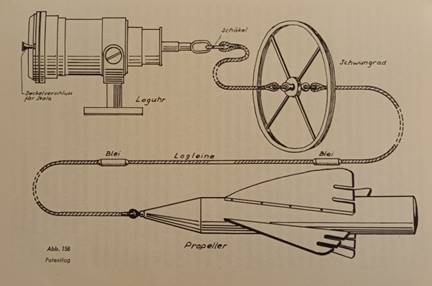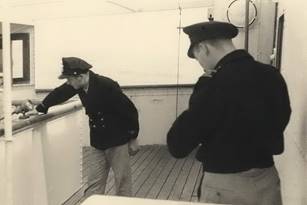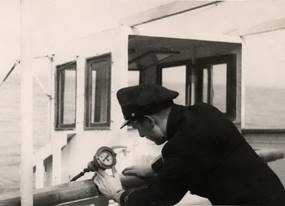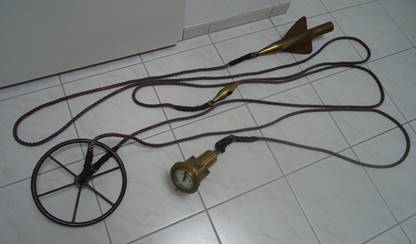
The ANUNCIADA with the hull number 759 was built by the traditional British shipyard William Doxford & Sons Ltd Pallion, Sunderland, England on behalf of Alpina Transports et Affrètments S.A. Antwerp and Companhia Suissa de Navegaçao Lda, Lisboa, subsidiaries of Schweizerische Reederei AG Basel. The launch took place on 10.12.1947 and the freighter was christened ANUNCIADA by Mrs. Anunciada Mari Pino, the daughter of director Ramon Mari Pino of Companhia Suissa de Navegaçao Lda. In July 1948, the ship was completed and delivered to her owners Anunciada Shipping Co. Inc. Panama, a company owned by Ramon Mari Pino and the Geneva banks Pictet & Co. and Ferrier Lullin & Co. The operation of the ANUNCIADA was taken over by Alpina Transports et Affrètments S.A. in Antwerp and she was registered first under the flag of Panama (register no.: unknown, call sign: HPDH) and then on 13.04.1949 she was registered under Swiss flag, retaining the same name (register no.: 23, call sign: HBDM).
On 13.04.1949 the ANUNCIADA was transferred without change of name to the ownership of the shipping company Transports Maritimes Suisse-Outremer S.A. Geneva, Switzerland and registered under Swiss flag (register No.: 23, call sign: HBDM).
On 01.01.1953, the management of the ship was transferred to the newly founded operating company Suisse-Outremer S.A. de Gérance et Affrètments Maritimes in Geneva.
The ANUNCIADA was a cargo motor vessel of the type built by the hundreds in Great Britain in the forties and fifties, with bridge and engine amidships, separated by hatch 3. Propulsion was provided by a diesel engine, often a Doxford model with opposed piston engine. Auxiliary power in the engine room and on deck (anchor and cargo winches) was mostly steam-powered, generated in one or two scotch boilers. Direct current was generated with steam dynamos and played a subordinate role, primarily used for lighting and smaller engines.
The navigation equipment on the bridge was also very basic and not necessarily up to the latest standard even at that time, there was no radar and an autopilot was only installed in later years. The bulkheads and ceilings of the cabins had no panelling, all bare steel. The captain and helmsmen, as well as the chief steward and the six passengers lived in the bridge superstructure, the engineers, stewards and cooks in the engine superstructure, where the galley was also located. A particular oddity, the radio operator's cabin was located aft in the engine superstructure, so the radio operator had a long way to get to the bridge, especially in an emergency (normally the radio operator's cabin was right next to the radio shack). The whole crew lived aft in two-berth cabins. There was no air conditioning at that time.
A so-called patent log was used to measure speed, as it was probably already used on sailing ships.

Schematic arrangement of a patent log

 Reading the speed log, fitted on the PS-bridge wing of the ANUNCIADA
Reading the speed log, fitted on the PS-bridge wing of the ANUNCIADA

The patent log of the freighter DIAM (ex-GISNA, Norwegian flag, year of construction 1960)
The log was towed behind the ship. The log clock as a fixed point was attached either to the railing aft or, as on the ANUNCIADA, right on the bridge. The propeller (about 400 cm long), which hangs on the log line, is brought outboard and towed about 100 metres behind the ship. The flywheel stabilises the line and ensures that the log rotates evenly. Normally, the log stays in the water during the whole passage, but care had to be taken that no seaweed or other material got entangled in the log.
ANUNCIADA's first time charter after her delivery was for the Federal Grain Administration in Bern and lasted five years. The voyages were mostly to the USA and Canada, but also to Argentina. Then followed two years with the SAL, South African Line, which worked together with the German DOAL. The line went from Northern Europe to Namibia, South Africa and Lourenco Marques. In the summer of 1956, the freighter made several voyages from Northern Europe to the St Lawrence River and Montreal. This was followed in 1957/58 by a long voyage from Northern Europe - Gulf of Mexico - Central America West Coast - Japan - Far East - Northern Europe - Argentina - Northern Europe. In April 1958, the ship went on-hire with the Tagus Line and made three voyages to West Africa, calling at lesser-known places such as the islands of Sao Thome and Fernando Po, Porto Alexandre Bay, Angola with the town of Tombua (then a fishing port). The Tagus Line was owned by Ramon Mari Pino, the former co-owner of ANUNCIADA. The last time charter from January 1959 until the sale of the ship was with the French Fabre Line to the Gulf of Mexico and West Indies. The last voyage was to Bhavnagar, India and to Durban, then through the Suez Canal back to Genoa, where the Swiss flag was taken down and the ship handed over to the Bulgarians. A major boiler repair or even a replacement of the steam boiler was under discussion, an expense the shipping company could no longer afford on the old steamer.
On a voyage from Montreal, Canada to Antwerp on Whit Monday morning, 02.06.1952, the boatswain Johann A. Moeller fell during painting work on the bridge from the staging onto the main deck, where he remained seriously injured. The captain sent a telegram to ask other ships for advice. The British passenger steamer MAURETANIA, which had a doctor on board, replied. After the boatswain's condition worsened, the two captains decided to sail towards each other, but the ships were about 250 nautical miles apart. At midnight, the two ships met and the MAURETANIA, despite high waves of 4-5 metres, launched a boat to pick up the injured man and put him in the care of the ship's doctor and nurses. After a day and a night, the boatswain was brought ashore in Cork, but unfortunately, he succumbed to his severe injuries in hospital despite the good care he received.
At the end of 1962, the bank Pictet & Co, Geneva gave up its activity as shipowner and sold its three A-ships, the ANUNCIADA, ALLOBROGIA and ARIANA to Suisse-Atlantique Société d'Armement Maritime S.A., Lausanne. On 09.03.1963, Suisse-Atlantique took over the operation of the ANUNCIADA.
In 1963, the ANUNCIADA was sold by the owners to the Bulgarian private trading company Imextracom Etablissement*) Vaduz, Liechtenstein / Varna and handed over to the new owners on 09.07.1963 in Genoa, Italy and deleted from the Swiss shipping register. The ship was renamed BENI SAF and registered under Bulgarian flag (register no.: unknown, call sign: LZEE). The management was taken over by Texim.
In 1967, the BENI SAF was transferred to the ownership of Navigation Maritime Bulgare, Varna, who had the ship scrapped in Bulgaria in 1974.
Sources:
- Federal Archive, Bern
- Bullaug (Magazine) and Walter Stamm, actuary, Schifferverein, Basel
- Guildhall, London
- Lloyd’s publications
- Capt. Jörg Johannsen
*) Note on Imextracom:
Georgi Ivanov Naydenov (1927 - 1998), in 1942 he joined the Bulgarian Partisan to fight against fascism. After the war, he worked in the Ministry of Foreign Affairs. In 1954, the Algerian struggle for independence against the French began. The Bulgarians wanted to support the struggle, but could not do so officially because of their good relations with France. Together with the Algerian revolutionary Mabet Sharef "Doctor Hashemi", Naydenov founded Bulgaria's first joint venture, Imextracom Establishment in Vaduz / Varna in 1961. The company supplied arms and equipment through the French blockade to Algeria (the first blockade runner was BREZA). The company bought its first two ships in 1963, one of which was the ANUNCIADA. The name Beni Saf is the hometown of Mabet Sharef, a small port town in western Algeria. In 1969, the company was nationalised at the instigation of Moscow and Naydenov had to serve five years in prison. The company still exists today as Texim Bank. His descendants run the company and studied in St. Gallen.
SwissShips November 2022 HPS, MB, JTA = Jeffrey T. Allanby
Notes arrived from Malcolm Cranfield. Deep sea voyages of the BENI SAF in LSI had included:
1967: Voyages from Med to West Indies and Rostock to Cuba
1968: From Black Sea in April to Djakarta via Gibraltar sailed Djakarta 8th June for Basrah and Dubai sailed Port Sudan 22nd September for Hamburg sailed Rotterdam 4th December to Izmir.
1970: Not listed until sailing from Bar to Port Sudan - passed Gibraltar 10th December, sailed Cape Town 11th January 1971
1971: Sailed Cuddalore 25th March for Gibraltar, SAILED CAPE TOWN 24th April 1971
...she then traded only in the Med/Black Sea.